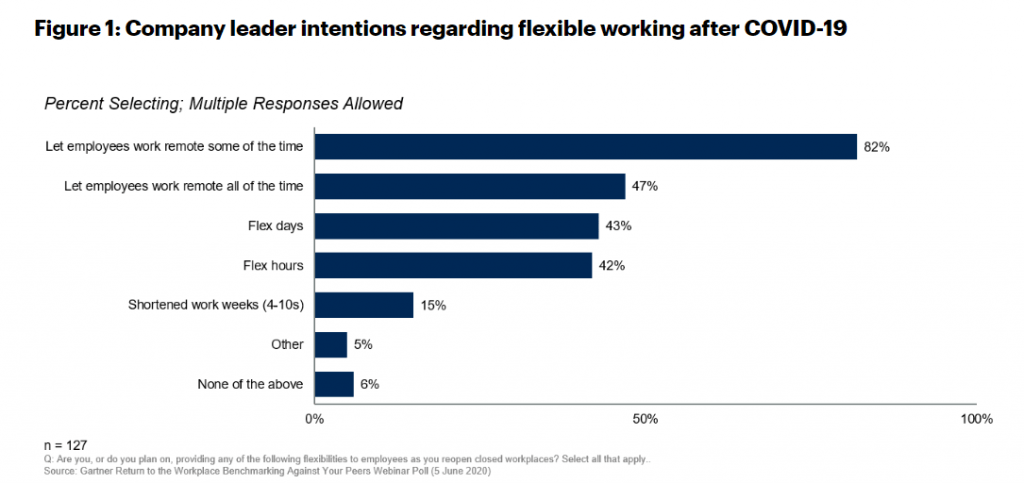As the COVID-19 pandemic has progressed and spread to almost all parts of the world, working from home has become the “new normal” for many employees. This paradigm shift, which was initially considered a temporary solution, now shows no signs of reversing in the foreseeable future, as cases are consistently on the rise.
Thus, corporate researchers have now become increasingly interested in studying the ins and outs of this particular organizational model, in order to improve the outcomes of work from home, for both employees and the organizations, in the present, as well as the future.
Gartner, Inc. conducted one such study to gauge company leaders’ opinions and plans regarding remote work. The study lent valuable insights into the scope of companies’ willingness to continue allowing employees to work from home after the pandemic comes under control, the major challenges to such a model, and prospective alternate in-office models.
82% in Favour of Remote Work
The responses collected from 127 company leaders in the US revealed that 82% of the respondents were on board with the idea of letting employees work from home sometimes.

While 47% were willing to allow full-time work from home all the time, 43% were in favour of incorporating flex days into the work schedule. The study also depicts that 42% found flex hours more suitable option for their company. Flex days are paid days off that do not fall under the company’s usual holiday roster. On the other hand, flex hours refer to a flexible schedule where the employee can choose when to start their workday and when to end it, granted they fulfil their daily hours of work within this window.
Safety Measures for Those being Called Back to Work
For companies calling back employees for in-office work, safety measures and precautions are a priority.
94% have taken active measures to reduce face-to-face contact as much as possible. 91% have equipped employees with protective tools such as face-masks and sanitizers.
Additionally, 83% of companies are implementing a strategy to control employee attendance. This is being done by either capping the number of employees being called in or managing the flow of employees from different departments in a sequential manner.
The Challenges of Supervising a Remote Workforce
The study also analyzed the upcoming road-blocks to the efficient direction of a remote workforce.
According to Elisabeth Joyce, a senior employee at Gartner HR, the network of remote employees has become more complex in recent times.
With regard to managing such a workforce, she said, “the question now facing many organizations is not how to manage a remote workforce, but how to manage a more complex, hybrid workforce. While remote work isn’t new, the degree of remote work moving forward will change how people work together to get their job done.”
This statement makes it clear that as a larger section of employees than ever before are fulfilling their duties virtually, the process of smooth coordination and communication among different departments, vertical tiers, and horizontal tiers needs to be seamless in order to ensure growth and output. No wonder only 4% of employees are willing to resume to work from the office they become more comfortable working from home.
While the responses towards tracking productivity were considerably relaxed, maintaining this productivity remains a foremost concern. This brings us to the most important findings of the research.
To ensure that the now-hybrid workforce functions well, company leaders are of the view that maintaining organizational culture (30%) and managing the employee experience (13%) will be the most useful tools.
Organizational Culture: Making or Breaking the Blueprint for Success
Organizational culture, or company culture, refers to the beliefs and values that guide an organization and its employees’ work. These values in turn impact performance expectations, identification of employees with the organization, and employee self-image. The importance of company culture in boosting growth has been validated by numerous studies due to reasons such as increased innovation, common values among employees, enhanced retention, etc. Thus, companies need to ensure that employees stay in touch with these values and expectations especially while working remotely, in order to deliver their best performance even outside of a formal office set-up.
An example of corporate culture clashing with remote work can be seen in Apple. The gadget behemoth is believed to have suffered the most due to work-from-home orders as stores closed to provide services virtually. This loss is partially attributed to Apple’s customer service policy, which favors hands-on, face to face interaction.
Employee Experience: Setting Clear Expectations
Similarly, positive employee experience has a number of benefits. Employee experience simply refers to the kind of environment an employee is exposed to during their tenure at a company. The link behind employee experience and company performance lies in the fact that when employees are successfully briefed about their roles and trained accordingly, they are bound to produce better results. Additionally, when the company provides the right tools and environment, it gives an added push to employees. Thus, it is no surprise that a pleasant employee experience can increase profits by 25%.
In a remote setting, employee experience can be managed by providing work essentials such as laptops and mobile phones, maintaining connectivity among teams and departments using the right software and platforms, and training employees to use all the tools provided to them.
As we’re learning more about remote working, a major shift in organizational norms is becoming evident, at least for the short run. Countries across the world are still divided about their stance on this new working culture. However, as the pandemic reaches new heights, many companies have caved. Moving forward, remote work, flexible hours, and 4 day work weeks might become more permanent than previously expected.

